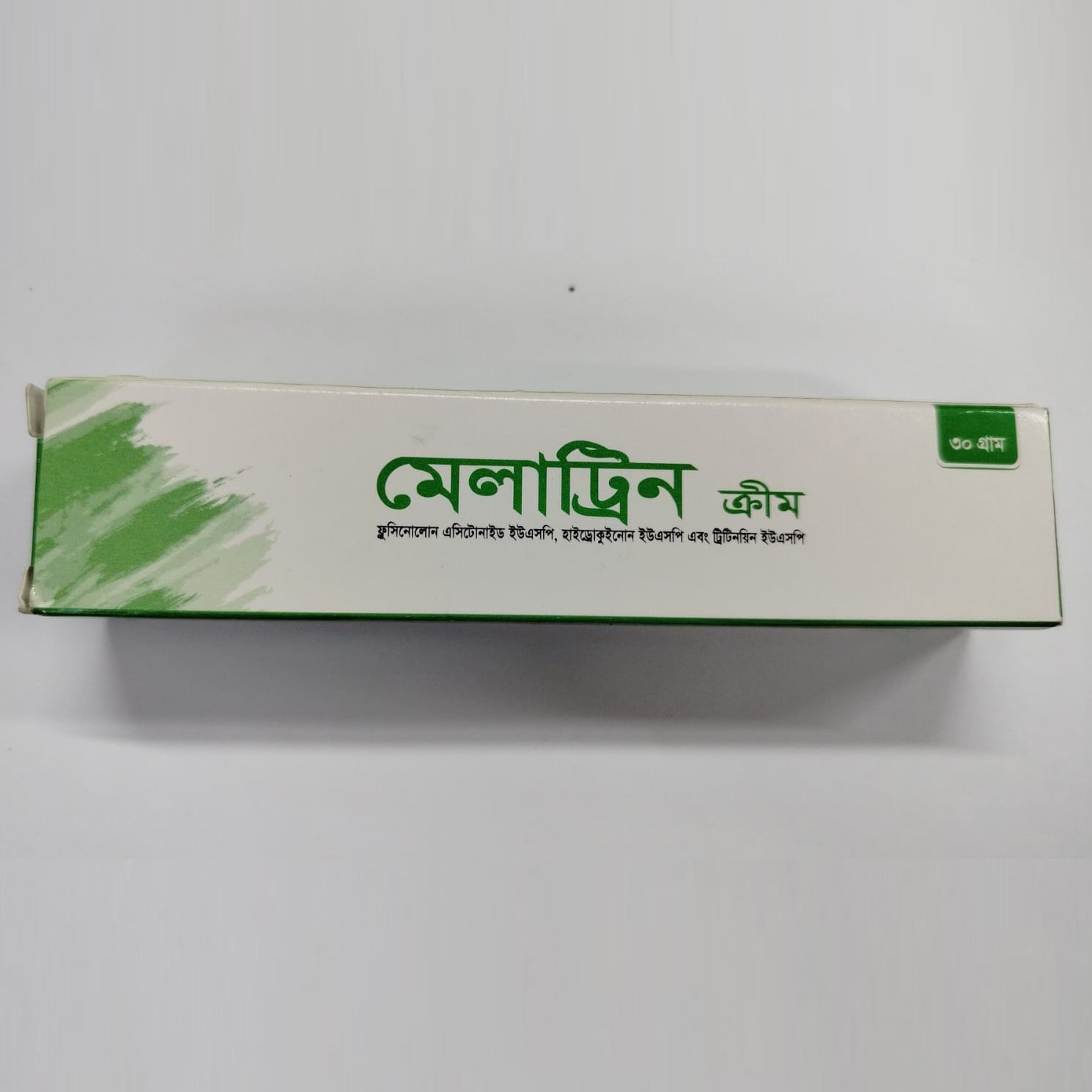Melatrin Cream
Pack Image
0.01%+4%+0.05%
30 gm tube:
৳ 200.00
Indications
This cream is indicated for the short-term treatment of moderate to severe melasma of the face, after starting the treatment avoid presence of sun. Use a sunscreen of at least SPF 30 or more.
Pharmacology
This cream contains three active ingredients Fluocinolone Acetonide, Hydroquinone and Tretinoin. All of them are used to treat melasma. However, the mechanism of action of the active ingredients in This cream in the treatment of melasma is unknown but Fluocinolone Acetonide is a corticosteroid for topical dermatological use and is classified therapeutically as an anti-inflammatory. Hydroquinone is classified therapeutically as a depigmenting agent, which may interrupt one or more steps in the tyrosine-tyrosinase pathway of melanin synthesis. Tretinoin is classified therapeutically as a keratolytic agent.
Dosage & Administration
This cream should be applied once daily at night. It should be applied at least 30 minutes before bedtime. Gently wash the face and neck with a mild cleanser. Rinse and pat the skin dry. Apply a thin film of the cream to the hyperpigmented areas of melasma including about ½ inch of normal-appearing skin surrounding each lesion. Rub lightly and uniformly into the skin. During the day, use sunscreen and wear protective clothing. Avoid sunlight exposure. Patients may use moisturizers and/or cosmetics during the day.
Pediatric Use: The safety and effectiveness of this cream in pediatric patients have not been established.
Pediatric Use: The safety and effectiveness of this cream in pediatric patients have not been established.
Interaction
Avoid use of medicated or abrasive soaps, cleansers, soaps, cosmetics with drying effects, products with high concentration of alcohol, astringent & other irritants or keratolytic drugs. Also avoid concomitant use of medications with photosensitizing effects.
Contraindications
This cream is contraindicated in individuals with a history of hypersensitivity, allergy or intolerance to this product or any of its components.
Side Effects
A very few patients may get severe allergic reactions from this cream. They may have trouble breathing or severe asthma attacks. While patients use this cream, skin may develop mild to moderate redness, peeling, burning, dryness or itching.
Pregnancy & Lactation
Pregnancy Category C. This cream contains the teratogen, tretinoin, which may cause embryo-fetal death, altered fetal growth, congenital malformations and potential neurologic deficits. It is difficult to interpret the animal studies on teratogenicity with this cream, because the availability of the dermal applications in these studies cannot be assured and comparison with clinical dosing is not possible. There are no adequate and well controlled studies in pregnant women. This cream should be used during pregnancy only if the potential benefit justifies the potential risk to the fetus.
Lactation: Corticosteroids, when systemically administered, the drug appear in human milk. It is not known whether topical application of this cream could result in sufficient systemic absorption to produce detectable quantities of Fluocinolone Acetonide, Hydroquinone or Tretinoin in human milk. Because many drugs are secreted in human milk, caution should be exercised when this cream is administered to nursing women.
Lactation: Corticosteroids, when systemically administered, the drug appear in human milk. It is not known whether topical application of this cream could result in sufficient systemic absorption to produce detectable quantities of Fluocinolone Acetonide, Hydroquinone or Tretinoin in human milk. Because many drugs are secreted in human milk, caution should be exercised when this cream is administered to nursing women.
Precautions & Warnings
This cream contains Hydroquinone and Tretinoin that may cause mild to moderate irritation. Local irritation, such as skin reddening, peeling, mild burning sensation, dryness and pruritus may be expected at the site of application. Transient skin reddening or mild burning sensation does not preclude treatment. If a reaction suggests hypersensitivity or chemical irritation, the use of the medication should be discontinued. This cream also contains the corticosteroid Fluocinolone Acetonide. Systemic absorption of topical corticosteroids can produce reversible Hypothalamic-Pituitary-Adrenal (HPA) axis suppression with the potential for glucocorticosteroid insufficiency after withdrawal of treatment. Manifestations of Cushing's syndrome, hyperglycemia and glucosuria can also be produced by systemic absorption of topical corticosteroid while on treatment. If HPA axis suppression is noted, the use of this cream should be discontinued. Recovery of HPA axis function generally occurs upon discontinuation of topical corticosteroids.
Therapeutic Class
Hydroquinone Preparations
Storage Conditions
Store in a cool & dry place, protected from light. Do not freeze. Keep out of reach of children.


